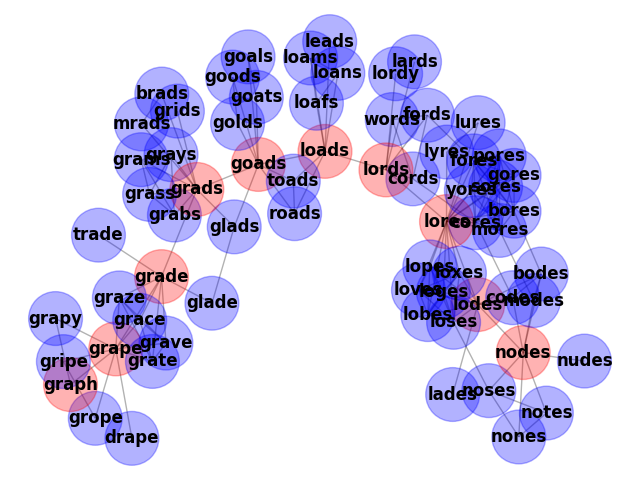备注
点击 here 下载完整的示例代码
文字/阶梯图#
在数据文件中的5757个5字母单词上生成无向图 words_dat.txt.gz . 如果两个单词在一个字母中不同,则它们通过一条边连接,从而产生14135条边。此示例在的第1.1节中描述
唐纳德E.克努特,“斯坦福图形:组合计算平台”,ACM出版社,纽约,1993年。http://www cs faculty.stanford.edu/~knuth/sgb.html
数据文件位于:

出:
Loaded words_dat.txt containing 5757 five-letter English words.
Two words are connected if they differ in one letter.
Graph named 'words' with 5757 nodes and 14135 edges
853 connected components
Shortest path between chaos and order is
chaos
choos
shoos
shoes
shoed
shred
sired
sided
aided
added
adder
odder
order
Shortest path between nodes and graph is
nodes
lodes
lores
lords
loads
goads
grads
grade
grape
graph
Shortest path between pound and marks is
None
import gzip
from string import ascii_lowercase as lowercase
import matplotlib.pyplot as plt
import networkx as nx
def generate_graph(words):
G = nx.Graph(name="words")
lookup = {c: lowercase.index(c) for c in lowercase}
def edit_distance_one(word):
for i in range(len(word)):
left, c, right = word[0:i], word[i], word[i + 1 :]
j = lookup[c] # lowercase.index(c)
for cc in lowercase[j + 1 :]:
yield left + cc + right
candgen = (
(word, cand)
for word in sorted(words)
for cand in edit_distance_one(word)
if cand in words
)
G.add_nodes_from(words)
for word, cand in candgen:
G.add_edge(word, cand)
return G
def words_graph():
"""Return the words example graph from the Stanford GraphBase"""
fh = gzip.open("words_dat.txt.gz", "r")
words = set()
for line in fh.readlines():
line = line.decode()
if line.startswith("*"):
continue
w = str(line[0:5])
words.add(w)
return generate_graph(words)
G = words_graph()
print("Loaded words_dat.txt containing 5757 five-letter English words.")
print("Two words are connected if they differ in one letter.")
print(G)
print(f"{nx.number_connected_components(G)} connected components")
for (source, target) in [("chaos", "order"), ("nodes", "graph"), ("pound", "marks")]:
print(f"Shortest path between {source} and {target} is")
try:
shortest_path = nx.shortest_path(G, source, target)
for n in shortest_path:
print(n)
except nx.NetworkXNoPath:
print("None")
# draw a subset of the graph
boundary = list(nx.node_boundary(G, shortest_path))
G.add_nodes_from(shortest_path, color="red")
G.add_nodes_from(boundary, color="blue")
H = G.subgraph(shortest_path + boundary)
colors = nx.get_node_attributes(H, "color")
options = {"node_size": 1500, "alpha": 0.3, "node_color": colors.values()}
pos = nx.kamada_kawai_layout(H)
nx.draw(H, pos, **options)
nx.draw_networkx_labels(H, pos, font_weight="bold")
plt.show()
Total running time of the script: ( 0 minutes 0.354 seconds)